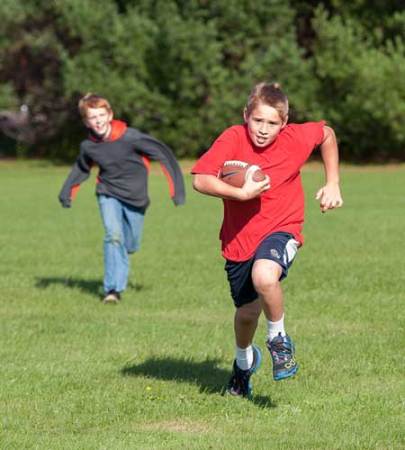Concussions have grown into a top concern for parents. Knowing the signs of concussion and how to help your athlete return to play following a head injury is an important part of keeping your young athlete safe on the field and court.

Concussions typically increase with the complexity and intensity of sports. As children get bigger, faster and stronger, there often is an increasing level of impact which increases the chance of a concussion.
Signs of concussions
Concussions are often seen in sports more physical in nature. This includes football, soccer, hockey and basketball. Not yet knowing the proper technique or taking proper precautions may increase your risk of concussions. This is seen in athletes learning to tackle or be tackled, learning how to fall properly, or learning how to dive for a ball.
“We often use a symptom score sheet, which contains 22 different concussion symptoms that are rated from zero to six,” said Jason Cerkony, licensed athletic trainer with Marshfield Clinic Health System. “These include a loss of balance, such as stumbling off the field or court, which we hear a lot about in football. Headaches, pressure in the head, sensitivity to light, sensitivity to noise, nausea, feeling sluggish, hazy, foggy or groggy, confusion and memory problems also are included.”
Other observable concussion symptoms include lying motionless, facial injury and a blank or vacant stare. Neurological signs of concussion include observing whether the patient can read aloud, if the patient can look side-to-side or up and down without double vision and if the patient can perform the finger to nose coordination test normally.
The onset of concussion symptom varies. Symptoms may develop immediately, or over the course of a few hours.
When diagnosing a concussion, providers do testing for orientation, immediate memory, concentration, delayed recall, balance testing, observable signs and symptom scoring.
What is a concussion?
A concussion is a form of a mild traumatic brain injury. Concussions happen when there is direct or indirect force to the head, which may affect the normal functioning of the brain.
Because concussions do not affect the brain structure, imaging, such as a CT or MRI, will not show any specific changes to the brain.
Following a concussion, neurons in the brain are vulnerable during early recovery, making it vital to follow appropriate guidelines throughout recovery and return to sport.
Concussion treatment
Immediate care consists of removing the athlete from play.
“The athlete should be assessed by a trained medical professional to assess for concussion and to lay out the plan for proper return to school and sport. The athlete’s return to play should involve a ‘return to play progression.’ This is a stepped progression of activity performed over multiple days,” Cerkoney said. “Licensed athletic trainers often play a vital role in creating this and may be involved in the establishment of a school care plan.”
It’s common for athletes with concussions to struggle in school during recovery, due to light and noise sensitivity and difficulty concentrating. A care plan is often created to help summarize the interventions needed to ensure a safe return to school.
To help prevent future concussions, proper strength and body control are vital.
“It’s also recommended athletes have the proper sports equipment and protective gear,” Cerkoney said. “It’s important to train athletes on the proper methods of falling and diving. Learning to fall while protecting the head and neck is a skill that can be practiced.”
Know when to seek emergency care
“While many signs and symptoms associated with concussions are not necessarily immediate cause for concern, there are things emergency care is recommended for,” he said.
Concussion signs and symptoms that warrant an emergency room visit include:
- Loss of consciousness
- Suspicion of spinal injury
- Skull fracture or brain bleeding
- Decreasing level of consciousness
- Looking drowsy and cannot be awakened
- Difficulty getting their attention
- Irregular breathing or vital signs
- Persistent or worsening vomiting
- Severe or worsening headache
- Seizure activity
- Difficulty remembering relevant people, events or facts
Following care or treatment for a concussion, it’s important to follow a gradual process to return to school or sports. Concussions are serious.
“The return to school and sports process needs to be approved and carefully managed by their provider and athletic trainer,” Cerkoney said.
For questions about concussions, talk to a Marshfield Clinic Health System provider.
Schedule appointment Message your provider
Related Shine365 articles
Kid’s sports physicals: Why it’s important
7 common summer sports injuries






Leave a Reply